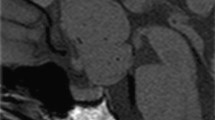Abstract
Introduction
Pituicytoma is a rare tumor of the pituitary gland derived from neurohypophyseal pituicytes.
Case 1
A 58-year-old female presented with decreased vision; she was admitted to the neurosurgery department of Ege University after the detection of a pituitary macroadenoma. Magnetic resonance imaging (MRI) showed a 28 * 18 * 17-mm suprasellar mass, and laboratory tests revealed hypopituitarism. Hydrocortisone and L-thyroxine treatment were initiated, and the patient underwent resection through the endoscopic endonasal approach (EEA). The histopathological examination revealed a pituicytoma. The recurrence of tumor was detected during the 1-year follow-up, and the patient is awaiting surgery.
Case 2
A 70-year-old woman presented with visual changes; she had a past medical history of hypophyseal macroadenoma and pituicytoma resected through an EEA in 2012 and 2017, respectively. During follow-up, 2 years after the second surgery, MRI showed progression of the pituicytoma then measuring 38 × 23 × 22 mm; it had invaded the cavernous sinus and was causing hydrocephaly and panhypopituitarism. The patient underwent the third resection through the transcranial approach in order to minimize bleeding. After this surgery, the patient developed diabetes insipidus and underwent treatment with desmopressin. Histopathological examination revealed a pituicytoma. At 6-month follow-up, imaging showed a sellar suprasellar mass 37 × 22 × 24 mm invading the cavernous sinus, indicative of recurrence. In the postoperative period, the patient applied to the department of radiation oncology to have fractionated radiotherapy.
Discussion
Pituicytomas are known to be low-grade tumors; because of their rarity, they are a real challenge. These patients should be followed up closely.






Similar content being viewed by others
References
Louis DN, Perry A, Reifenberger G, von Deimling A, Figarella-Branger D, Cavenee WK et al (2016) The 2016 World Health Organization Classification of Tumors of the central nervous system: a summary. Acta Neuropathol 131(6):803–820
Asa SL, Mete O (2019) Hypothalamic endocrine tumors: an update. J Clin Med 8(10):1741
Lee EB, Tihan T, Scheithauer BW, Zhang PJ, Gonatas NK (2009) Thyroid transcription factor 1 expression in sellar tumors: a histogenetic marker? J Neuropathol Exp Neurol 68(5):482–488
Brat DJ, Scheithauer BW, Staugaitis SM, Holtzman RN, Morgello S, Burger PC (2000) Pituicytoma: a distinctive low-grade glioma of the neurohypophysis. Am J Surg Pathol 24(3):362–368
Gibbs WN, Monuki ES, Linskey ME, Hasso AN (2006) Pituicytoma: diagnostic features on selective carotid angiography and MR imaging. AJNR Am J Neuroradiol 27(8):1639–1642
Lefevre E, Bouazza S, Bielle F, Boch AL (2018) Management of pituicytomas: a multicenter series of eight cases. Pituitary 21(5):507–514
Mete O, Lopes MB (2017) Overview of the 2017 WHO Classification of pituitary tumors. Endocr Pathol 28(3):228–243
Vaquero J, Leunda G, Cabezudo JM, Salazar AR, de Miguel J (1981) Granular pituicytomas of the pituitary stalk. Acta Neurochir (Wien) 59(3–4):209–215
Hurley TR, D’Angelo CM, Clasen RA, Wilkinson SB, Passavoy RD (1994) Magnetic resonance imaging and pathological analysis of a pituicytoma: case report. Neurosurgery 35(2):314–317 (discussion 17)
Shah B, Lipper MH, Laws ER, Lopes MB, Spellman MJ (2005) Posterior pituitary astrocytoma: a rare tumor of the neurohypophysis: a case report. AJNR Am J Neuroradiol 26(7):1858–1861
Koutourousiou M, Gardner PA, Kofler JK, Fernandez-Miranda JC, Snyderman CH, Lunsford LD (2013) Rare infundibular tumors: clinical presentation, imaging findings, and the role of endoscopic endonasal surgery in their management. J Neurol Surg B Skull Base 74(1):1–11
Tian Y, Yue S, Jia G, Zhang Y (2013) Childhood giant pituicytoma: a report and review of the literature. Clin Neurol Neurosurg 115(10):1943–1950
Neidert MC, Leske H, Burkhardt JK, Kollias SS, Capper D, Schrimpf D et al (2016) Synchronous pituitary adenoma and pituicytoma. Hum Pathol 47(1):138–143
El Hussein S, Vincentelli C (2017) Pituicytoma: Review of commonalities and distinguishing features among TTF-1 positive tumors of the central nervous system. Ann Diagn Pathol 29:57–61
Sahm F, Reuss DE, Giannini C (2018) WHO 2016 classification: changes and advancements in the diagnosis of miscellaneous primary CNS tumours. Neuropathol Appl Neurobiol 44(2):163–171
Viaene AN, Lee EB, Rosenbaum JN, Nasrallah IM, Nasrallah MP (2019) Histologic, immunohistochemical, and molecular features of pituicytomas and atypical pituicytomas. Acta Neuropathol Commun 7(1):69
Pirayesh Islamian A, Buslei R, Saeger W, Fahlbusch R (2012) Pituicytoma: overview of treatment strategies and outcome. Pituitary 15(2):227–236
Karamchandani J, Syro LV, Uribe H, Horvath E, Kovacs K (2012) Pituicytoma of the neurohypophysis: analysis of cell proliferation biomarkers. Can J Neurol Sci 39(6):835–837
Mende KC, Matschke J, Burkhardt T, Saeger W, Buslei R, Buchfelder M et al (2017) Pituicytoma-An outlook on possible targeted therapies. CNS Neurosci Ther 23(7):620–626
Acknowledgements
We are grateful to Dr. Celal Çınar, who made tumor embolization by interventional radiology and gave the images of embolization. We are grateful to Ahmet Topacoglu for his grammar support.
Author information
Authors and Affiliations
Corresponding author
Ethics declarations
Consent to publish
The authors confirm that the patients provided their consent for the publication of their medical and personal information.
Informed consent
Written informed consent was obtained from all patients.
Conflict of interest
The authors declare that they have no conflict of interest.
Additional information
Publisher's note
Springer Nature remains neutral with regard to jurisdictional claims in published maps and institutional affiliations.
Rights and permissions
About this article
Cite this article
Ozisik, H., Yurekli, B.S., Simsir, I.Y. et al. Two challenging cases of pituicytoma. Hormones 20, 813–818 (2021). https://doi.org/10.1007/s42000-021-00301-6
Received:
Accepted:
Published:
Issue Date:
DOI: https://doi.org/10.1007/s42000-021-00301-6




